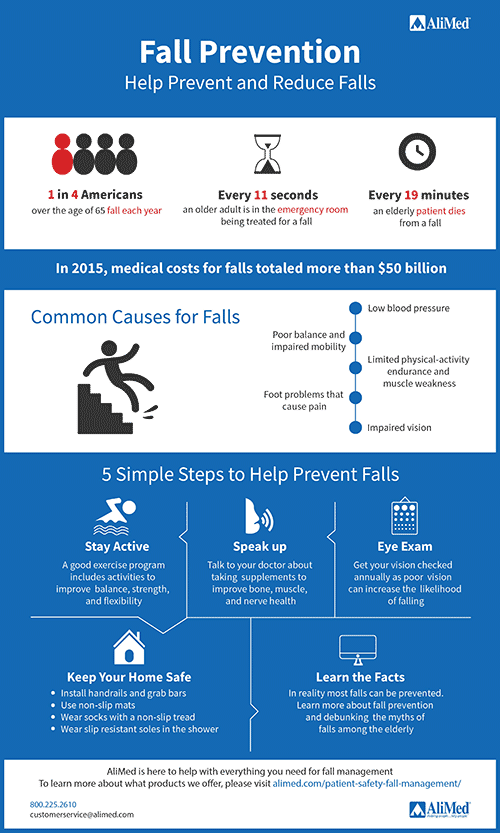-
Home
-
Falls Prevention Awareness Day
Falls Prevention Awareness Day
September 10, 2018

Download a printable poster here.
September 22, 2018, is Falls Prevention Awareness Day, and AliMed wants to help spread the word to promote awareness on how to help prevent and reduce falls among older adults.
Facts: Older Adults Fall in the US1
- 1 in 4 Americans over the age of 65 falls each year
- Every 11 seconds, an older adult is in the emergency room for a fall
- Every 19 minutes, an elderly patient dies from a fall
According to the National Council on Aging, falls are the leading cause of fatal and non-fatal injuries amongst the elderly.2 These falls can also lead to the loss of independent living and even falls without permanent injury can cause anxiety of falling which can lead to depression, social isolation, and physical decline.3 Falls are also costly. In 2015, medical costs for falls totaled more than $50 billion and were projected to increase to $67.7billion by 2020.4 Individuals with the highest risk of falling include those with5:
- Low blood pressure
- Poor balance and impaired mobility
- Limited physical-activity endurance and muscle weakness
- Foot problems that cause pain
- Impaired vision
However, many falls can be substantially reduced by making lifestyle changes and by participating in evidence-based programs that focus on physical activity and education on how to reduce falls and improve overall health and wellbeing. A combination of factors put patients at risk of falling. Let’s take a look at five things you can do decrease your chances of falling.
Stay active: A good exercise program includes activities to improve balance, strength, and flexibility.6 Learn more about exercise and other programs to help prevent falls on the National Council on Aging's website.
Speak up: Talk to your healthcare provider to evaluate your risk for falling. Have your doctor review your medications to make sure side effects aren’t increasing your chances of falling. Talk to your doctor about taking supplements to improve bone, muscle, and nerve health.
Get regular eye exams: Get your vision checked annually as poor vision can increase the likelihood of falling. Determine if you need a new prescription and if you have progressive lenses, you may want to also get a pair of glasses with only your distance prescription as these types of lenses can make objects appear closer or farther away than they are.
Keep your home safe: Did you know that 75% of falls occur inside or in close proximity to the home?7 Below are some simple changes that can significantly reduce the risk of falling at home.
- Remove things you can easily trip over such as shoes and clothes.
- Wear socks with a non-slip tread
- Use double-sided tape to keep small area rugs from slipping.
- Install handrails on both sides of staircases.
- Improve lighting in your home with brighter light bulbs.
- Install grab bars in your tub and shower and next to the toilet.
- Use non-slip mats in the tub and other areas that may get wet and slippery and wear slip-resistant soles to help avoid slips and falls in the shower.
- Move frequently used items in the kitchen, like plates and glasses, within reach. If you must place some items out of reach, avoid using a step stool or chair and use assistive reaching devices instead.
Learn the facts: Many people believe falling is inevitable and a normal part of aging, when in reality most falls can be prevented. Learn more about fall prevention and debunking the myths of falls among the elderly on the National Council on Aging's website.
Download a printable fall management poster here.
References
- https://www.ncoa.org/wp-content/uploads/2017-Evidence-Based-Falls-Programs-Infographic-1.pdf
- https://www.ncoa.org/healthy-aging/falls-prevention/
- https://www.ncoa.org/wp-content/uploads/2017-Evidence-Based-Falls-Programs-Infographic-1.pdf
- https://www.cdc.gov/homeandrecreationalsafety/falls/adultfalls.html
- https://www.americannursetoday.com/assessing-patients-risk-falling/
- https://www.ncoa.org/wp-content/uploads/NCOA-Falls-Free-Infographic-680pixels-0917.pdf
- https://www.ncoa.org/blog/falls-prevention-home-18-step-safety-checklist/
You may also be interested in: